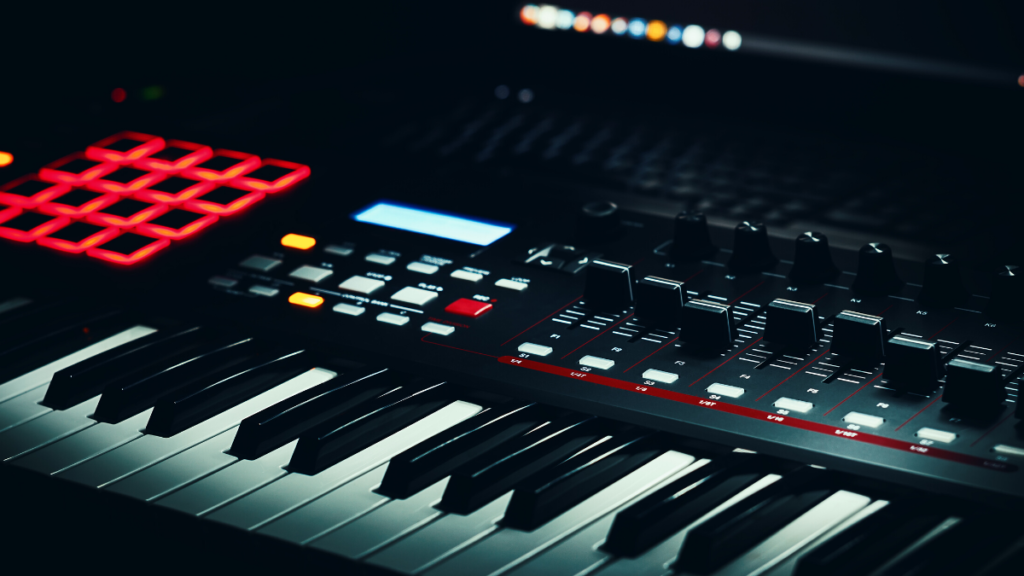MIDI, or Musical Instrument Digital Interface, is a technical standard that allows electronic musical instruments, computers, and other related devices to communicate, control, and synchronize with each other. It was first introduced in the early 1980s and has since become a fundamental technology in the music industry. Here’s a comprehensive overview:

Key Aspects of MIDI
- Data Format:
- MIDI transmits information about musical notes and events rather than actual audio. This includes data such as note on/off, pitch, velocity (how hard a note is played), control changes (like volume, modulation), and program changes (instrument sounds).
- Components:
- MIDI Controllers: Devices like keyboards, drum pads, and wind controllers that generate MIDI data.
- MIDI Interfaces: Hardware that connects MIDI devices to computers or other devices.
- MIDI Sequencers: Software or hardware used to record, edit, and play back MIDI data. Popular DAWs (Digital Audio Workstations) like Ableton Live, Logic Pro, and FL Studio have built-in MIDI sequencers.
- MIDI Sound Modules: Hardware or software that receives MIDI data and generates sound accordingly.
- Connection Types:
- Traditional 5-pin DIN Connectors: The original standard for physical MIDI connections.
- USB MIDI: Allows MIDI data to be transmitted over USB cables, commonly used in modern MIDI controllers.
- Wireless MIDI: Uses Bluetooth or Wi-Fi for wireless MIDI communication.
How MIDI Works
- Channels and Messages: MIDI data is sent over 16 channels, allowing multiple instruments to be controlled independently within a single system. MIDI messages can be channel-specific (like note on/off messages) or system-wide (like timing and synchronization messages).
- MIDI Messages:
- Note On/Off: Indicates when a key is pressed or released.
- Control Change: Alters parameters such as volume, pan, modulation, and sustain.
- Program Change: Switches between different instrument sounds or patches.
- Pitch Bend: Adjusts the pitch of notes smoothly.
- System Exclusive (SysEx): Allows manufacturers to define their own specific messages for unique functions.
Applications of MIDI
- Music Production:
- MIDI is extensively used in music production for sequencing, arranging, and controlling virtual instruments within DAWs.
- It allows precise editing of musical performances, including quantizing (correcting timing errors), transposing, and changing instrument sounds without re-recording.
- Live Performance:
- Musicians use MIDI controllers to trigger sounds, loops, and effects in real-time during live performances.
- MIDI can synchronize lighting and visual effects with music for a cohesive live show experience.
- Film Scoring and Composition:
- Composers use MIDI to create mock-ups of orchestral scores, allowing for detailed revisions and approval before recording with live musicians.
- MIDI can control virtual instruments that emulate orchestral sounds.
- Educational Tools:
- MIDI-based software and hardware are used for music education, helping students learn to play instruments and understand music theory interactively.
Advantages of MIDI
- Flexibility: MIDI data can be easily edited and manipulated, providing great flexibility in music creation and production.
- Portability: MIDI files are small in size compared to audio files, making them easy to share and store.
- Interoperability: MIDI’s standardized format ensures compatibility across different devices and software.
Limitations of MIDI
- Sound Quality: MIDI itself does not produce sound; it relies on sound modules or virtual instruments, so the quality of the sound depends on the quality of the sound sources used.
- Complexity: Understanding and using MIDI can be complex for beginners due to the technical nature of the protocol and the variety of available control messages and settings.
MIDI continues to evolve with advancements like MIDI 2.0, which aims to enhance the standard with higher resolution, better timing, and more expressive control, ensuring that MIDI remains a cornerstone of music technology for years to come.
For a look at how MIDI can be used in a DAW such as Ableton here is a good guide.
